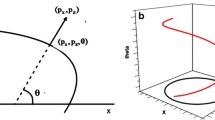Abstract
Based on Fermat’s principle, two-point ray tracing method was studied in three-dimensional structure. By means of first order Taylor’s incomplete series expansion (i.e. no expansion to the length of the ray), a symmetry block tridiagonal matrix equation set was deduced. Further, the positive definiteness of coefficient matrix was discussed, and the positive definiteness was accurately proved in a mathematical way. It assured that the algorithm was well-posed. Associated with iterative method, the solution to ray tracing can be got through step-by-step linearized iteration of the nonlinear problem. An algorithm of the whole path iterative ray tracing method in three-dimensional velocity structure was obtained. This method shows a clear and simple as well as explicit computation formula, which makes ray tracing computation easily applicable in practice. The correction vector is obtained through finding the solution to the positive definite block tridiagonal equation set, which ensures the method is robust convergence. This study offers a new kind of feasible and efficient ray tracing method for three dimensional seismic migration and tomography. Meanwhile, it also provides the prerequisite guarantee to design a fast algorithm.
Similar content being viewed by others
References
KARAL F C, KELLER J B. Elastic wave propagation in homogeneous and inhomogeneous media[J]. J Accoust Soc Am, 1959, 31(6): 694–705.
ČERVENÝ V, MOLOTKOV I A, PŠENČÍK I. Ray Method in Seismology[M]. Prague: Charles University Press, 1977.
FARRA V. Bending method revisited: a Hamiltonian approach[J]. Geophys J Int, 1992, 109(1): 138–150.
GAO Er-gen, XU Guo-ming, ZHAO Yi. Segmentally-iterative ray tracing method for any interface[J]. Oil Geophysical Prospecting, 1998, 33(1): 54–60. (in Chinese)
GAO Er-gen, XU Guo-ming. A new kind of step by step iterative ray-tracing method[J]. Acta Geophysica Sinica, 1996, 39(S): 302–308.(in Chinese)
GAO Er-gen, XU Guo-ming, Li Guang-pin, et al. A new total iterative ray-tracing method in random interface[J]. Acta Custica, 2002, 27(3): 282–287.(in Chinese)
SAMBRIDGE M S, KENNETT B L N. Boundary value ray tracing in heterogeneous medium: a simple and versatile algorithm[J]. Geophys J Int, 1990, 101(1): 157–168.
UM J, THURBER C H. A fast algorithm for two-point seismic ray tracing[J]. Bull Seis Soc Am, 1987, 77(3): 972–986.
XU Guo-ming, WEI Shan, GAO Er-gen, et al. Block model-building and ray-tracing in 2-D complicated medium[J]. Oil Geophysical Prospecting, 2001, 36(2): 213–219.(in Chinese)
CHIU S K L, KANASEWICH E R, PHADKE S. Three-dimensional determination of structure and velocity by seismic tomography[J]. Geophysics, 1986, 51(8): 1559–1571.
FARRA V. Ray tracing in complex media[J]. J Appl Geophys, 1993, 30(1): 55–73.
LIU Hong, MENG Fan-lin, LI You-ming. The interface grid method for seeking global minimum travel-time and the correspondent ray path[J]. Acta Geophysica Sinica, 1995, 38(6): 823–832.(in Chinese)
VIDALE J E. Finite different calculation of travel-time in three dimensions[J]. Geophysics, 1990, 55(5): 521–526.
MA Zheng-ming, LI Yan-da. Two-step ray tracing method[J]. Acta Geophysica Sinica, 1991, 34(4): 501–508. (in Chinese)
YANG Chang-chun, LENG Chuan-bo, LI You-ming. Fast and accurate ray tracing in 3-D media[J]. Acta Geophysica Sinica, 1997, 40(3): 414–420. (in Chinese)
YANG Wen-cai, LI You-ming, LI Shi-xiong, et al. Applied seismic Tomography[M]. Beijing: Geological Press, 1993. (in Chinese)
ZHANG Lin-bin, YAO Zhen-xing, JI Chen. Finite difference calculation of seismic first-arrival travel-time[J]. Progress in Geophysics, 1996, 11(4): 47–52. (in Chinese)
ZHOU Zhu-sheng, ZHANG Sai-min, CHEN Ling-jun. Seismic ray tracing calculation based on parabolic travel-time interpolation[J]. J Cent South Univ Technol, 2004, 11(2): 199–205.
Author information
Authors and Affiliations
Corresponding author
Additional information
Foundation item: Project(40674071) supported by the National Natural Science Foundation of China; project(KFAS2002-2003) supported by Korea Foundation for Advanced Studies
Rights and permissions
About this article
Cite this article
Gao, Eg., Han, U. & Teng, Jw. Fast ray tracing method in 3-D structure and its proof of positive definiteness. J Cent. South Univ. Technol. 14, 100–103 (2007). https://doi.org/10.1007/s11771-007-0020-5
Received:
Accepted:
Issue Date:
DOI: https://doi.org/10.1007/s11771-007-0020-5




